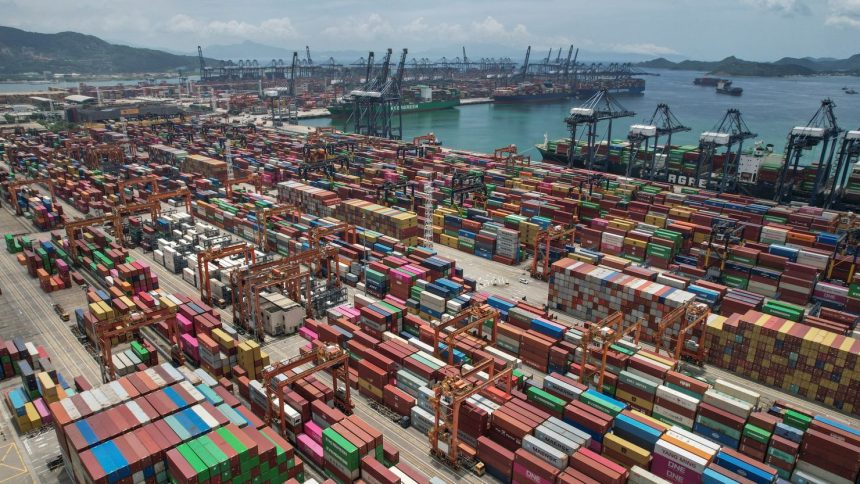New York
CNN
—
If you’re inclined to roll your eyes at the stuffy academics shouting about the damage tariffs do to the economy, I get it. “Tariff” is just one of those words that makes your eyelids feel as heavy as they did in your 9 a.m. undergraduate econ class.
But if you don’t want to heed the many, many economists’ warnings about former President Trump’s fringe economic plans, take it from the people running the companies that make the stuff you buy: Prices will go up. How much and how fast is hard to know, but you can bet your bottom dollar you’ll be needing more dollars to pay for everyday goods if Trump’s sweeping tariffs are put in place.
“If we get tariffs, we will pass those tariff costs back to the consumer,” said Philip Daniele, CEO of AutoZone, on an earnings call in September.
AutoZone also won’t need to wait until the policies are enacted, Daniele noted. Once they know what the markup will be, “we generally raise prices ahead of that.”
A quick primer on tariffs: They’re a tax on imported goods — clothes, shoes, toys, car parts, appliances, you name it. But the extra money does not come from the foreign companies that produce those goods. The American company doing the importing pays the money to the US Treasury. And more often than not, that means you, the consumer, pay for the tariff.
This isn’t speculation or theory, it’s just the way tariffs work — and we have the last six years of global trade to prove it.
In 2018, during his first term, Trump imposed tariffs of 30% to 50% on goods imported from China, forcing Beijing to retaliate with its own tariffs against US goods like aluminum, airplanes, cars, pork and soybeans. And we’ve been in a tit-for-tat trade war with China ever since.
You might not have noticed the changes all at once, and the pandemic came along to muck up supply chains and drive prices even higher. But several studies conclude that the cost of those tariffs were borne almost entirely by American consumers and businesses. By the end of 2019, the average US household paid nearly $500 more on average in a year, according to one analysis.
This time around, if he’s reelected, Trump has proposed a 20% tariff across the board on all US imports — something we’ve never seen before — and even steeper duties of 60% against China and other major trading partners. That radical policy could cost the typical middle-income US household more than $2,600 per year, according to research from Peterson Institute for International Economics.
Trump has repeatedly lied about this fact, claiming foreign entities would pay for the added costs. The most generous interpretation of Trump’s tariff plan would be that he’s trying to force US businesses to move their overseas operations back on US soil, creating jobs. But you don’t need an MBA or an econ degree to know that US labor is expensive, and that could drive prices higher.
Even if tariffs could undo decades of globalization, it likely wouldn’t have the effect Trump is hoping for.
Just ask Timothy Boyle, the CEO of Columbia Sportswear, who told investors recently that “the argument about tariffs improving the domestic production of items such as footwear and apparels are fallacious …. the commodities that we engage in with footwear and apparel are among the most highly tariffed in United States. Some of the product carries as much as nearly 40% duties, and that has not translated into increased investment in domestic production.”
In an interview with the Washington Post last week, Boyle was more direct, saying the company is already planning to raise prices. “We’re buying stuff today for delivery next fall. So we’re just going to deal with it and we’ll just raise the prices. … It’s going to be very, very difficult to keep products affordable for Americans.”
Not all products would get an immediate price increase, to be clear. Big businesses with wider margins tend to be able to absorb at least part of the added cost before passing it on to consumers.
Consider one of Trump’s own for-profit endeavors, the Trump Bible, which the Associated Press revealed last month to be the product of a China-based printing company (not an uncommon practice in the publishing world, but ironic nonetheless for a politician who has spent years blasting China’s trade policies). The AP found the $59.99 Trump Bibles cost less than $3 per book to print.
With that kind of markup, the Trump-owned company behind the Bibles could probably swallow the cost of the president’s tariffs, plus shipping and other fees, without raising prices.
And big companies like Walmart and Target can (and do) manage to keep prices steady because, given their scale, they’re able to negotiate terms with their suppliers.
But small businesses, which employ roughly half of the American workforce, aren’t in the same position. They are often narrow-margin, high volume operations with less wiggle room on prices. Most of the time that means business either have to jack up prices or significantly cut costs — and that’s when the layoffs begin.




